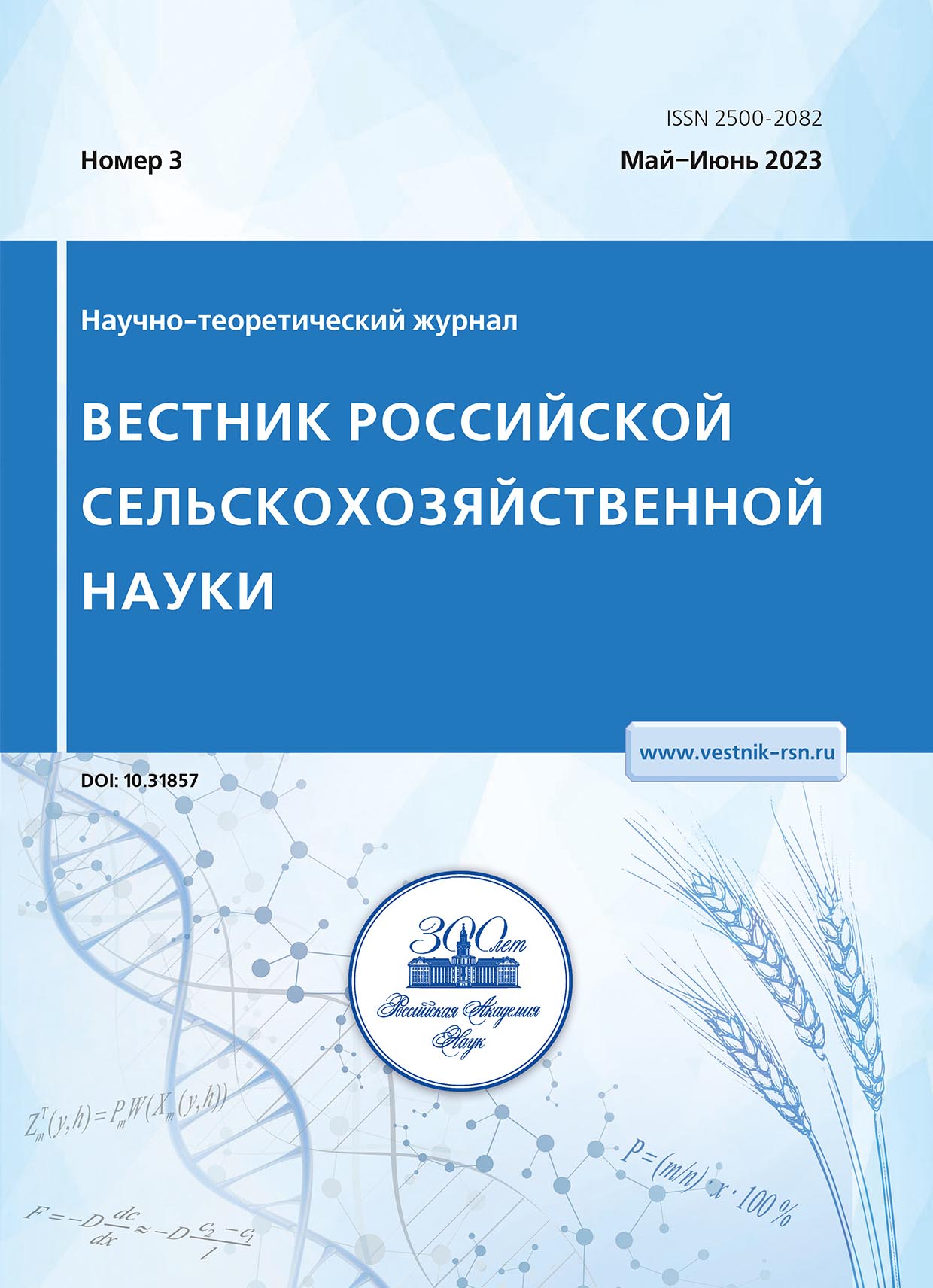MODEL OF WINTER SOFT WHEAT VARIETY FOR STEPPE CONDITION ZONE
Abstract
Due to the increased aridization of the environment in the main agricultural zones of the Don, the parameters of the model of winter soft wheat varieties of intensive and semi-intensive types have been clarified. At the present stage, the potential productivity of intensive wheat at a high agrofone is 9,0-10,5 t/ha of grain, which is due to the productive stem of 660-800 ears/m2. In semi-intensive varieties on the average agrophone, the values of these indicators are respectively 7,0-7,5 t/ha and 580-620 ears/m2. The productivity of the ear, respectively, should be 1,2-1,5 g and 1,1-1,2 g and with a grain share in the cenosis of 40-45% and 36-38%, respectively. With different stress factors, the peculiarities of the formation of agroecotypes of new varieties were revealed. The selection criterion for drought-resistant productive forms was the selection of genotypes with a high yield index. However, the main trend related to productivity and adaptability in drought conditions is the creation of new genotypes with increased grain weight from the plant and from the ear. This is the most objective integrated assessment of their drought resistance. The progress in the yield growth of semi-dwarf and medium-sized wheat varieties is also due to an increase in the capacity of cenosis. as a result of the use of new parameters of the model of intensive and high-intensity genotypes, varieties of winter soft wheat Donmira, Akapella, Bogema, Bylina Dona i Pal'mira 18, Kuryanochka 19, Pafos, developed for the Central Chernozem, North Caucasus, Lower Volga, Middle Volga and Ural regions, were created and included in the State Register of Breeding Achievements in 2019-2022. These varieties are well adapted for arid regions according to the complex of breeding and valuable traits.
References
2. Vavilov N.I. Teoreticheskie osnovy selekcii pshenicy. M.: Nauka, 1987. 506 s.
3. Grabovec A.I. Donskoj metod opredeleniya morozostojkosti i zhiznesposobnosti ozi-myh hlebov. Rostov-na-Donu: Yug. 2010. 23 s.
4. Grabovec A.I. O modeli sorta ozimoj myagkoj pshenicy dlya uslovij Dona // Selekciya i semenovodstvo. 1983. №2. S.10-13.
5. Grabovec A.I., Fomenko M.A. Nekotorye aspekty sozdaniya i vyyavleniya transgressiv-nyh vysokoproduktivnyh rekombinantov ozimoj pshenicy// Rossijskaya sel'skohozyaj-stvennaya nauka. 2022. № 5. S. 3-7. DOI: 10.31857/S2500262722050015
6. Zhuchenko A.A. Vozmozhnosti starta rossijskogo APK v XXI stoletie//Agrarnyj Vest-nik Yugo-Vostoka. 2009. №1. S. 6-12.
7. Ivanov A.L., Edelgeriev R.H., Donnik I.M. i dr. Global'nyj klimat i pochvennyj pokrov Rossii: proyavleniya zasuhi, mery preduprezhdeniya, bor'by, likvidaciya posledstvij adaptacionnye meropriyatiya (sel'skoe i lesnoe hozyajstvo)/ Nacional'nyj doklad (monografiya). T.3. M.: MBA. 2021. S. 700. DOI:10.52479/978-5-6045103-9-1
8. Karakotov S.D., Karlov G.I., Pryanishnikov A.I., Divashchuk M.G., Hverenec S.E., Titov V.N., Popova V.M. K ispol'zovaniyu algoritmov markernoj selekcii dlya uluchsheniya sortov ozimoj pshenicy/ Vestnik agrarnoj nauki. 2022. №3(96). S. 29-32. DOI: 10.17238/issn2587-666X.2022.3.8
9. Kovtun V.I., Kovtun L.N. Model' sorta myagkoj ozimoj pshenicy intensivnogo tipa dlya uslovij yuga, yugo-vostoka i central'no-chernozemnoj zony Rossii//Sel'skohozyajstvennyj zhurnal. 2022. №1 (15). S. 13-22. DOI: 10.25930/2687-1254/002.1.15.2022
10. Matishov G.G., Dashkevich L.V., Kirillova E.E. Ciklichnost' klimata v Priazov'e: so-vremennyj period (19-21vv)// Doklady Rossijskoj Akademii nauk. Nauki o zemle. 2021. №1. T. 458. S. 96-100. DOI: 10.31857/S2686739721050091
11. Petrov L.K. Ocenka urozhajnosti, ekologicheskoj stabil'nosti i plastichnosti sortov ozimoj pshenicy// Rossijskaya sel'skohozyajstvennaya nauka. 2020. №3. S. 6-9. DOI: 10.31857/S2500262720030023
12. Pryanishnikov A.I., Savchenko I.V., Mazurov V.N. Adaptivnaya selekciya: teoriya i praktika otbora na produktivnost'//Vestnik Rossijskoj sel'skohozyajstvennoj nauki. 2018. №3. S. 29-32. DOI:10.30850/vrsn/2018/3/29-32
13. Suhorukov A.F., Sukorukov A.A. Sovershenstvovanie modeli sorta ozimoj pshenicy dlya uslovij srednego Povolzh'ya// Izvestiya Samarskogo nauchnogo centra Rossijskoj aka-demii nauk. 2015. №3-4 (t. 17) – S. 473-48.
14. Ahmad Z., Waraich E.A., Akhtar S., Anjum S., Ahmad T., Mahboob W., Hafeez O.B.A., Tapera T., Labuschagne M., Rizwan M. Physiological responses of wheat to drought stress and its mitigation approaches// Acta Physiologiae Plantarum. 2018. 40: 80 DOI: 10.1007/s11738-018-2651-6


